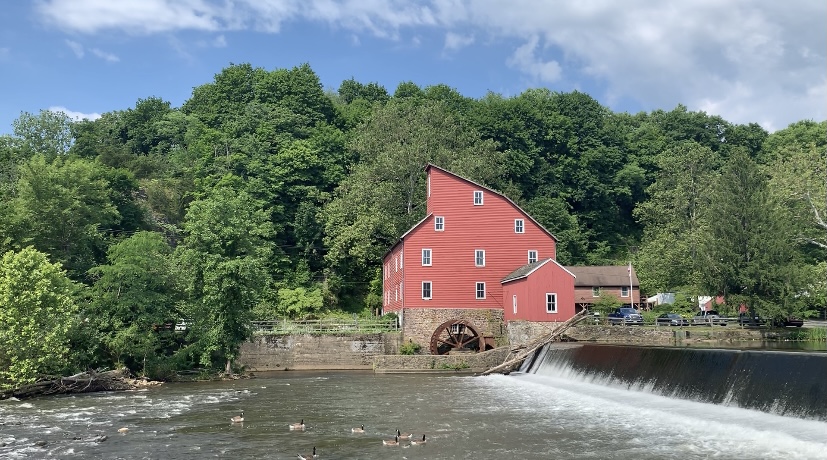Hunterdon County’s Red Mill Museum
January 19, 2021
We can all picture it–the bright red color and the rushing waterfall provide for a picturesque view and a great experience that overall represents the Red Mill Museum. Those who enjoy history, art, and culture tend to enjoy spending quality time at this location, and the museum serves as a great part of Hunterdon County.
The Red Mill Museum located in Clinton, New Jersey, has an extensive collection that shows over 40,000 permanent and rotating agricultural, industrial and domestic items. Each piece in the collection includes a description of who made it and the chain of people who used it in their lives. This includes Red Mill Museum visitors who, by taking their stories to friends and family, keep these objects alive. In permanent displays, many artifacts are shown, which show the story of how the culture evolved from Colonial times through to the closing of the Mill in 1928. Some permanent exhibits in the Mulligan Quarry buildings give visitors the chance to hear the stories of the Mulligan family business and the Irish immigrants who work in stone.
Five people in the community, known as the Red Mill Five, acted with vision and bravery when they bought the Red Mill to restore it as a museum. They include Cyrus Fox, who owned the lumberyard of Cyrus R. Fox, Inc., Ralph Howard, a restaurateur who owned and operated the Clinton House, Robert Lechner, a teacher who founded and managed a camp in Stanton, a well-known artist and musician named James Marsh, and finally, Monroe DeMott, who was the president of a real estate and insurance firm named Shive, Wright, and Exton.
Their story began in 1960, when the Red Mill Five, led by James Marsh and Monroe DeMott, eventually managed to purchase the Red Mill landmark for $15,000 on the west bank of the South Branch of the Raritan River. The Red Mill Five met at Clinton House for the next 12 years, at noon on Fridays, to turn their vision into reality. Ruth Hetherington, the executive secretary of Monroe DeMott, became the secretary of the Red Mill Five for 12 years and was an important part of their formative Clinton House meetings. The first three years were about serious, hands-on, physical labor as the large empty building was cleaned and repaired, the roof and water wheel replaced, and a collection started with donations from the local community. Dorothea Connolly was hired as a curator, and she completed the first exhibits of old clothes, games, a kitchen display, and an exhibit for girls at the Mill. In 1963, Clinton’s Historical Museum opened to the public. Claire Young later became a staff curator in the footsteps of Dorothea Connolly and started to fill the Mill with exhibits, including a Victorian bedroom and parlor, a World War I living room and kitchen, and a wheelwright shop.
The Mulligan Quarry was purchased by James Marsh in 1964 and donated to the museum, and finally, in 1965, the museum and grounds were formally dedicated. The Red Mill Five were able to transfer the baton by 1972, and other members of the group came in to continue their mission to preserve the Mill, its collections, and the local heritage. In 1996, the museum expanded and became known as the Hunterdon Historical Museum over the years and became the Red Mill Museum Village in 2002.
When the Kentucky Derby Party, one of the organization’s biggest single-day fundraisers, had to be permanently canceled, it was difficult for the museum. In previous years, it earned upwards of $32,000, and it was soon realized that it would be hard to replace. However, the event was able to regroup by addressing donors directly. The strategic message for donors is to remind members of the central mission of the association, pivoting from an emphasis on supporting programs to sponsoring the vision.
Although visitors and donors are the key members for every museum, the pandemic today often needs a renewed emphasis on workers. For staff, the strategic message they receive is that they are respected and appreciated. This outreach helped to relieve some of their concern and apprehension when the Red Mill Museum held its first Zoom conference for employees. Transparent dialogue and truthful engagement, especially under such uncommon conditions, are often crucial to maintaining high morale. The Red Mill Museum leaders understand that nurturing an enthusiasm for the project, engaging with the group, alleviating the fears of workers and other stakeholders, and keeping in contact with all stakeholders to keep active would be the key to handling this pandemic.
